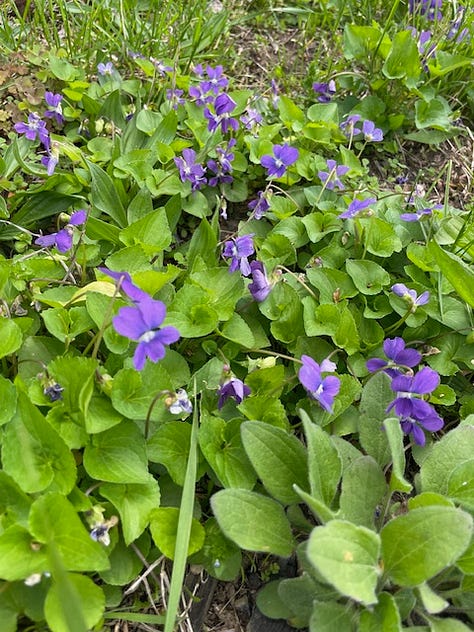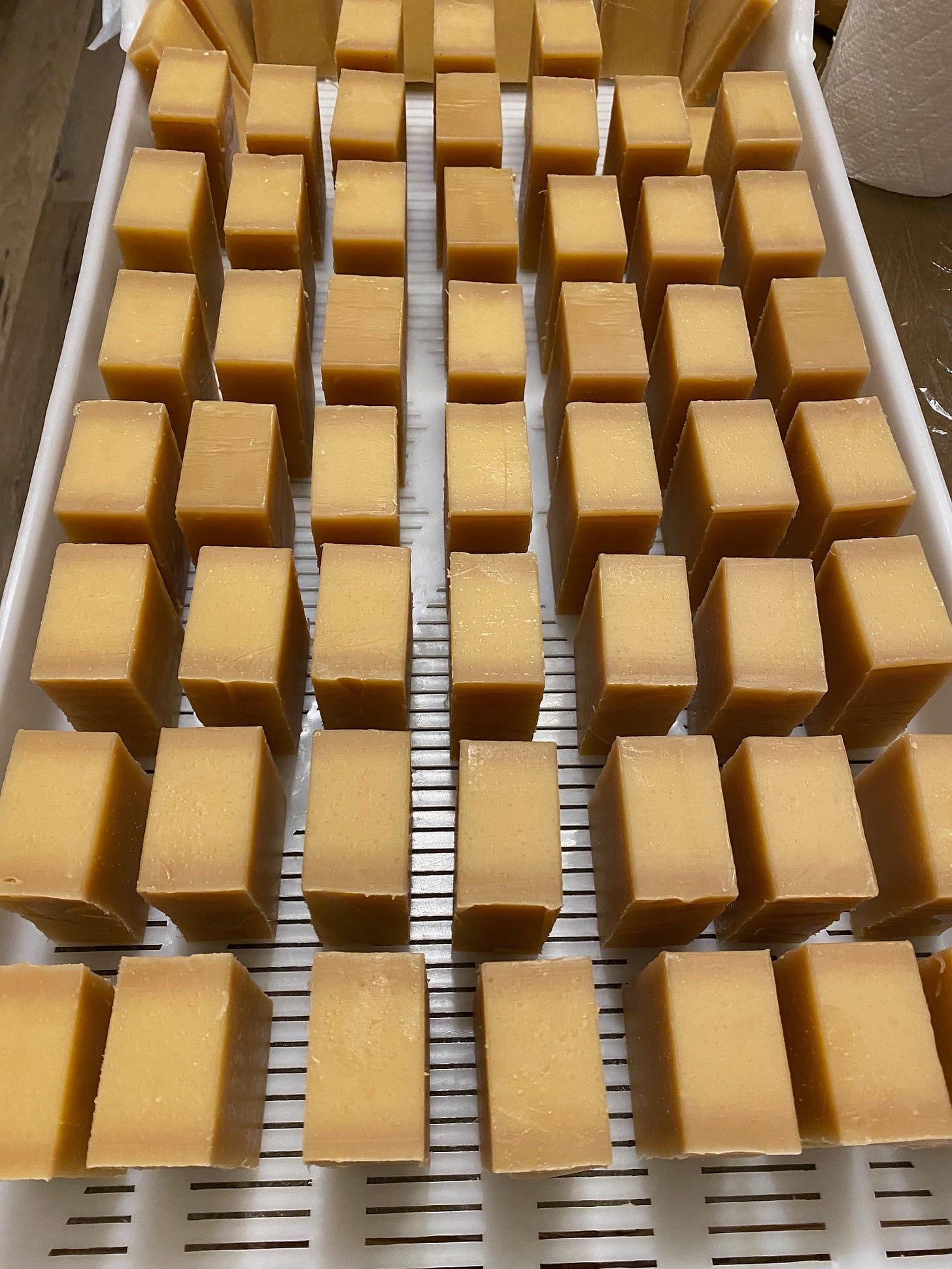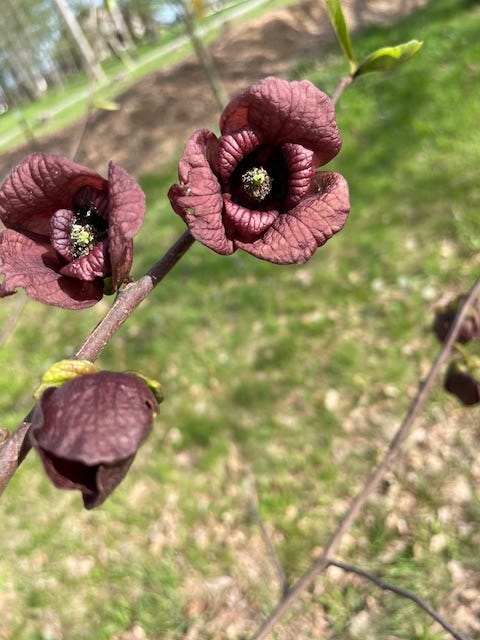Generations ago, there was a designated wash day, dedicated to cleaning the clothes, which was an arduous process before that spinning machine that so many people now have, or rent. At weedom there’s a similar long work day during which large quantities of soap is made. We have a little biz, and now there is time to grow it a bit. That means bringing production up to a higher scale that we can tolerate within our existing space.
This scaling up is a rocky road. Seem that some of those who produce the smaller scale equipment needed for batching don’t necessarily have a familiarity with materials engineering, and that’s a story for another day.
Cold process soap requires the use of either sodium hydroxide (a.k.a. lye) or potassium hydroxide, (or perhaps a mix of the two, but that’s not easy). These strong alkaline chemicals convert fat molecules (triglycerides) to salts of their fatty acids, (leaving behind glycerin in the process). The fatty acid salts (which are the soap) dissolve in water, and due to their unique molecular structure, with a polar end and a non polar end, are capable of emulsifying, and allowing water to carry away dirt from you, or various and sundry items among your possessions. In general, sodium hydroxide is used to make bar soap and potassium hydroxide is used to make liquid soap.
We make lots of soap in our kitchen, and yes, it’s for sale locally, and online to a limited extent.
Every soapmaker has a specialty, and ours is herbal soap. Many of you have discovered the joys of hand crafted soap, which, if made correctly, is easier on your skin than that which is manufactured to contain highly efficient, grease cutting detergents. It turns out that one’s skin needs to retain the naturally produced oils, which are there for protection. Hand crafted soap tends to leave more of your skin oils intact, and can leave behind a bit of their own excess oils which are not soluble in water.
That’s the true claim to fame for this type of soap. Many of the infinite variety of other additives found in hand crafted soaps do fairly little by comparison. That’s because soap is a rinse-off product. Little of the additives remain on your skin for prolonged periods. So, for example, CBD soap is cute, but the CBD can’t do anything for you after you rinse it off. Some of the additives add qualities to the soap, but not so much to your skin. Goat milk can add to the sudsiness of soap, but, again it’s rinsed off, and therefore can’t transform your skin in amazing ways. The other main consideration is that many soap additives are altered by the strong alkaline reaction with the sodium hydroxide.
We choose to add herbal teas to many of our soaps, not so much for direct skin benefits, but to remind people what these freely available weeds can do if if more directly applied. They also seem to prolong the life of our soaps. We experience fewer problems with oxidation of residual oils among the soaps which contain these herbal teas. Some compounds, such as the plant saponins can be converted to quite useful aglycones (sapinogenins) under the alkaline conditions of the lye reaction. Such chemistry might account for the enduring popularity and usefulness of jewelweed soap, but we certainly will avoid publishing any extra claims of benefit. :-D
We have chosen to exclusively make the bar soap, because the benefits of not stripping your skin of its oils far outweigh the downside.
no cracked and bleeding skin from handwashing
less dryness itching and flaking
much reduced need for lotion.
massively reduced waste in the land fill, and no plastic bottles.
compact size,
long lasting product, and usability often improves with age.
infinite possibilities for pleasing scents or no scent if that’s preferred.
What’s the downside?
need to clean the soap deck (tray), and perhaps more residue in your sink or tub if you have hard water.
It’s well worth the trouble.
As for trouble: Everytime we mix and stir, something unplanned happens. Sometimes it’s good and sometimes not. This time one of our jars of wild violet tea cracked while thawing. Since exactly no one thinks glass is a great exfoliant, that tea was a total loss, even though the jar stayed together ( in a sort of phone screen fashion) as thawing slowly proceeded. Fortunately the wild violets are all around us, so we quickly picked a bunch of leaves and blooms, and made very fresh tea, which steeped while we made the other soap batches.



At the end of the day, there were six slabs of soap in the molds, which we’ll cut into bars in a couple days. Those cure on our racks, usually for about a month until we wrap and label them.
Part of our newest process is to dry the herbs so that all the herb teas are made immediately before making soap. To this end, we have inaugurated our new freeze dryer, and the first weed we dried was catnip.
Announcing something which might affect your weedom experience for awhile:
Reproduction is happening here, and we’re not talking about cows, although that’s happening too. Brand new human baby units are expected within the family very soon, in May and June, so we will be pre-occupied with all that naturally goes on with such productivity. 😎 Please be patient with reduced writing output during this time. Please check SubStack notes and chat if we go missing in your email for too long. Our newest readers will benefit from hitting the May and June posts of 2023 to guide them in their weed wanderings, if we fail to post during a particular week. Archives remain fully open, and we hope All of you are taking advantage of them.
Don’t miss the amazing weeds of spring, and feel free to use all the SubStack social areas to share the fun. SubStack notes allows you to post videos, as well as photos, so it has become a much more interesting place. Let us know what you’re seeing out in the weeds!











Congratulations on your impending delivery! Take as long as needed - Family first all the way. Shared to Tumblr